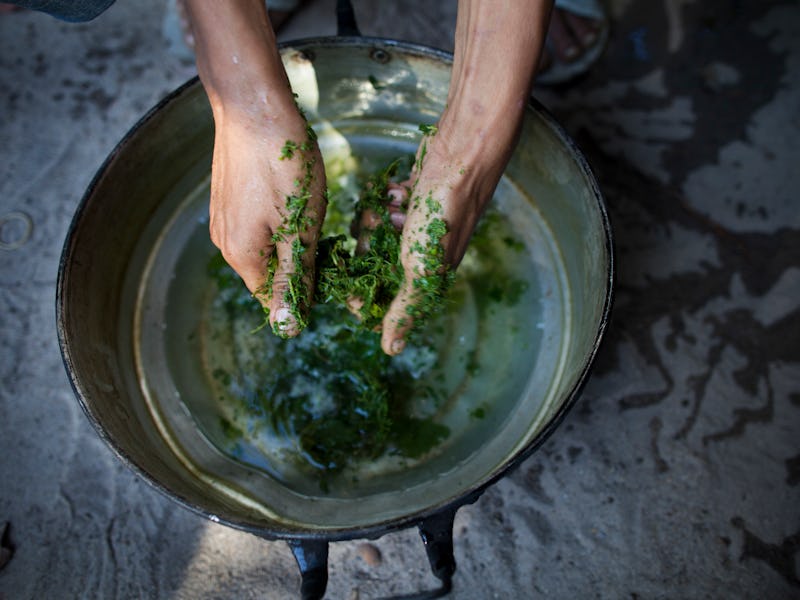The Psychoactive Opioid Kratom Can Force a Broader Drug Legalization Debate
The leafy green drug's Xanax-like high has officials itching to ban it, but it has the potential to treat addiction to more serious drugs.

As the pot debate rages on, kratom, a psychoactive drug made from the leaves of a Southeast Asian tree, is quietly flooding the online recreational drug market. Its Xanax-like high, rumored side effects, and addictive potential have some state drug enforcers itching to ban it. But, as physicians at a Wisconsin hearing pointed out on Tuesday, it’s a lot less dangerous than the prescription opioids that have almost 9 million Americans in their grip. It might even offer a way to help.
Is kratom fated to undergo unnecessary criminalization, following in the steps of its now widely accepted and medically beneficial green predecessor? The answer to that question is relevant not only for users, but for precedent.
The scientific data needed to make a reasoned decision is lacking, but history provides the necessary framework. In Thailand, the leaves were traditionally chewed by field laborers seeking an extra boost, much like coca leaves in Peru. Planting the kratom-producing Mitragyna speciosa tree became illegal in 1943 — but not necessarily for safety reasons: Some officials have argued that the ban was enacted because kratom offered a way out of opium addiction at a time when the opium industry was raking in profits. Despite the ban, which was almost overturned in 2013 to help wean addicts off harder drugs like meth, kratom tea still remains popular, most often cut with cough syrup and Coca Cola to make a cocktail known locally as “4x100.”
America’s relationship with the drug is still in its early stages. The DEA classifies it as a “drug of concern” but hasn’t banned it outright. Kratom’s major psychoactive substance, an alkaloid called mytraginine, has opioid-like effects — stimulation and pain relief at low doses, sedation at high doses, and euphoria at even higher ones. Different varieties (stateside, our relationship with kratom is still in its early stages) — “Bali” for euphoria, “Green Vein Kali” for painkilling and stimulation — are comically easy to buy online.
In Thailand, kratom tea is mixed with cough syrup and Coca Cola to make a narcotic cocktail known as "4x100."
Different varieties promise different highs — “Bali” for euphoria, “Green Vein Kali” for painkilling and stimulation — thanks to compounds that also trigger serotonergic and adrenergic activity.
These effects can be fun: Kratom can provide everything from relaxation to a boost in sex drive to stress relief. Because kratom can trick the brain into feeling like it’s on morphine, its effects can also be helpful. This is specifically true in regards to opioid addicts, a not inconsiderable American population. Those concerned with their or other’s prescription drug abuse have used it as substitute for physically addictive opioids like hydrocodone, documenting their experiences on message boards all over the internet.
Which is all to say that kratom is undoubtedly a drug and doubtedly a dangerous one. Its arrival on the U.S. market and adoption as a psychoactive aperitif would have, in the past, put drug enforcement agencies in the Caesarian position of giving a thumbs up or thumbs down. Inaction would be the more radical action. But, in the wake of states legalizing marijuana, the law-and-order default no longer represents political self inoculation. Unnecessary drug bans — and all drug bans are considered unnecessary to some — are politically unpopular and often heaped in medical and scientific scorn. Kratom is unlikely to become part of the mainstream drug debate, but its positive effects could make it a martyr if a ban is instituted.
That’s not to say that kratom doesn’t have negative effects or addictive potential. Withdrawal causes hostility, aggression, and diminishment of emotional control. And the lack of sound data on its effects make self-medication a risky endeavor. The supply chain is also questionable at best. Buying drugs off the internet, though common practice, is generally more dangerous than not buying drugs off the internet. But, like weed, kratom seems to strike a rare balance: It offers noticeable effects but appears to be (pending study) relatively benign.
There is plenty of reason for the government to finance or conduct research on kratom but little reason to ban it without reproducible results. That, of course, augurs nothing unless drug agencies confirmation bias has diminished in strength or changed vector.
Kratom is the drug to watch. It could represent the frothy front of a coming wave of commercially available psychoactive remedies and it could represent nothing but itself, the prunings of a non-native species.